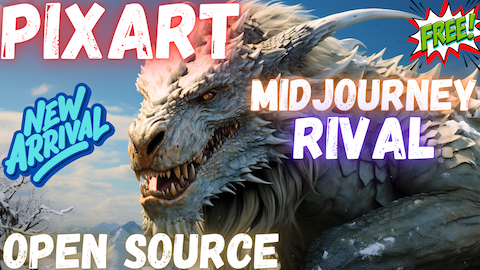-
-
Notifications
You must be signed in to change notification settings - Fork 305
PIXART‐α : First Open Source Rival to Midjourney ‐ Better Than Stable Diffusion SDXL ‐ Full Tutorial
Tutorial Link : https://youtu.be/ZiUXf_idIR4
PIXART-α : First Open Source Rival to Midjourney - Better Than Stable Diffusion SDXL - Full Tutorial
Introduction to the new PixArt-α (PixArt Alpha) text to image model which is for real better than Stable Diffusion models even from SDXL. PixArt-α is close to the Midjourney level meanwhile being open source and supporting full fine tuning and DreamBooth training. In this tutorial I show how to install and use PixArt-α both locally and on a cloud service RunPod with automatic installers and step by step guidance.
The link to download resources
Stable Diffusion GitHub repository
SECourses Discord To Get Full Support
PixArt Repo
#PixArt #StableDiffusion #SDXL
- 0:00 Introduction to PixArt-α: Fast Training of Diffusion Transformer for Photorealistic Text-to-Image Synthesis and the tutorial content
- 2:38 What are the requirements to follow this tutorial and install PixArt Alpha
- 3:05 How to install PixArt Alpha on your machine and start using it
- 3:59 Where Hugging Face models are downloaded by default and how to change this default cache folder
- 5:44 How to return back to using default Hugging Face cache folder
- 6:08 How to fix corrupted files error during installation
- 6:29 How to start PixArt Web APP after installation has been completed
- 7:24 How to use PixArt Web APP and its features
- 7:59 Comparing a dragon prompt with SDXL base version
- 8:14 How to use provided styles csv file
- 8:40 How to start Automatic1111 SD Web UI on your second GPU
- 8:50 Where the PixArt Web APP generated images are saved
- 9:30 How to set parameters in your Automatic1111 SD Web UI to generate high quality images
- 9:49 PixArt generated image vs SDXL generated image for same simple prompt
- 10:15 Anime style same prompt comparison
- 10:55 One another strong aspect of the PixArt Alpha model
- 11:29 Fantasy art style comparison of SDXL vs PixArt-α
- 11:52 3D style comparison of SDXL vs PixArt-α
- 12:16 Manga style image generation comparison between SDXL vs PixArt-α
- 12:44 Comparing PixArt vs SDXL vs Midjourney with same prompt
- 13:41 How to use LLaVA for captioning and obtaining prompt ideas and generating more amazing images
- 16:12 Comparison of PixArt vs SDXL prompt following in details
- 17:29 Getting prompt idea from ChatGPT and comparing SDXL and PixArt prompt following
- 19:46 PixArt owns hard the SDXL with this new detailed prompt
- 22:00 How to install PixArt on a RunPod pod / machine
- 23:54 How to set default Hugging Face cache folder on RunPod / Linux machines
- 25:05 How to understand RunPod machine / pod is not working correctly and fix it
- 26:00 How to properly delete files / folders on RunPod machines / pods
- 26:51 How to connect and use PixArt web UI on a RunPod machine after it was started
- 28:20 How to download all of the generated images on RunPod with runpodctl very fast
The paper introduces PIXART-α, a Transformer-based text-to-image (T2I) diffusion model designed to significantly lower training costs while maintaining high image generation quality, competitive with leading models like Imagen and Midjourney. It achieves high-resolution synthesis up to 1024x1024 pixels at reduced training costs.
Key Innovations:
Training Strategy Decomposition: The process is divided into three steps focusing on pixel dependency, text-image alignment, and image aesthetic quality. This approach reduces learning costs by starting with a low-cost class-condition model and then pretraining and fine-tuning on data rich in information density and aesthetic quality.
Efficient T2I Transformer: Built on the Diffusion Transformer (DiT) framework, it includes cross-attention modules for text conditions and streamlines computation. A reparameterization technique enables loading parameters from class-condition models, leveraging prior knowledge from ImageNet, thus accelerating training.
High-informative Data: To overcome deficiencies in existing text-image datasets, the paper introduces an auto-labeling pipeline using a vision-language model (LLaVA) to generate captions on the SAM dataset. This dataset is selected for its diverse collection of objects, aiding in creating high-information-density text-image pairs for efficient alignment learning.
Image Quality: The model excels in image quality, artistry, and semantic control, surpassing existing models in user studies and benchmarks.
Broader Implications: The paper suggests that PIXART-α's approach allows individual researchers and startups to develop high-quality T2I models at lower costs, potentially democratizing access to advanced AI-generated content.
The paper concludes with the hope that PIXART-α will inspire the AIGC community and enable more entities to build their own generative models efficiently and affordably.










